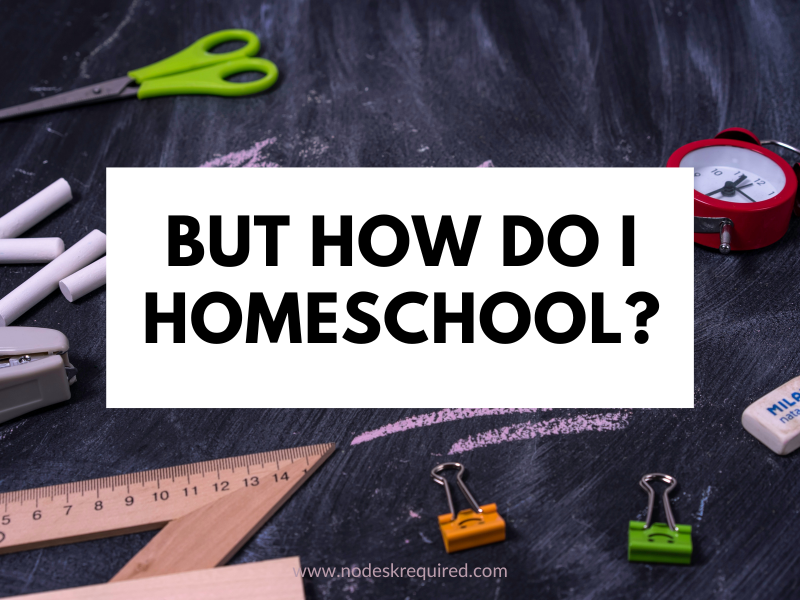But HOW Do I Homeschool?

You’ve read the law, found a local homeschool group, and even bought a planner . . . but you still don’t know what to do with the kids. This post was written to help anyone who is still wondering, “but how do I homeschool?”
At its most basic, homeschooling is simply preparing your children for their adult lives. What each child will need when they’re grown will vary, but there are some basics that every educated person should know. Your goal is to ensure that your child has learned those basics and understands how to access more information when they want or need it.
No parent, teacher, school system, or college can cover everything an individual should know in their lifetime, but a good education will set them up for success by giving them the tools they need to find the answers as they need them.
Step 1: Write down why you’re homeschooling. What is your goal?
Everyone will have their own reasons for homeschooling. Many Christian homeschooling families choose to keep their children at home to have more guidance and opportunities to share their faith, but that’s not the case for all families. It could be that you want to travel as a family, or that you don’t want to miss so much of their childhood. Perhaps you need to catch your kids up, and then you’ll be re-enrolling them in a more traditional school setting. Maybe they weren’t safe at school and you’re keeping them home to protect them from physical harm.
Whatever your reasons, make sure you write them down clearly and keep your “manifesto” somewhere you can pull it out on the hard days (and there will be hard days), as a reminder to yourself of why your children are home.
Step 2: Write down what you consider the most essential things your kids need to know when they graduate.
Try to keep the list short and sweet, and don’t get bogged down in the details yet. “Math through algebra, and financial planning” is better than “addition, subtraction, multiplication, division, fractions . . . ” If you’re having trouble creating a list, here are a few good resources.
- What Your Child Needs to Know When by Robin Sampson
- The Educated Child by William J. Bennett
- What Should I Be Teaching My Child?
- The Checklist by Cindy Downes
- Typical Course of Study from World Book Encyclopedia
- Homeschooling the Young Learner
- The Core Knowledge Series by E.D. Hirsch
Step 3: Find out your preferred educational method.
I’ve linked up to several quizzes on my New to Homeschooling? page and recommend you check them out if you’re not already familiar with the various homeschooling methods (Charlotte Mason, unschooling, unit studies, etc.). Knowing what educational methods you lean towards will be extremely helpful for the next step, when you’re looking at curriculum options.
Step 4: Curriculum shop!
Now that you know what your child should be learning (step 2) and a general idea of how (step 3), it’s time to tackle the curriculum. Do you want to stick with a classical approach? Teach math and language arts separately but cover everything else through unit studies? Go full on unschooling? Keep your answers in mind as you look at resources to help you narrow down the choices that will be the best fit for your family.
If you can physically look through the curriculum you want to check out, that’s always best. Check with your local homeschool group to see if there’s a local homeschool shop, or if they do a “curriculum show and tell” type of event. If you need to buy online, I have some favorite places listed on the Where to Buy Curriculum page.
There are a lot (and I mean a lot!) of wonderful curriculum options available and it can be easy to become overwhelmed, or to want to use them all. I once heard of a mom who was having her child go through three math programs at the same time, because they were all good and she didn’t want to have to choose between them. Please don’t do that to your child! Pick one that seems well-suited to what your goals are, and how your child will best learn (videos, hands-on, etc.), and stick with it for awhile. If you find it’s not working, you have the freedom to change it up, but don’t add on – that’s setting both you and your child up for frustration and failure.
Step 5: Breathe. Then dive in.
It can feel overwhelming, but after a little while you’ll start to understand your new rhythm. Start slowly, if you need to. Maybe just math and some read-alouds together. Then work the rest in as you’re ready.
After the first year, many people say they can’t imagine ever doing anything else!
Step 6: Enjoy your new life!
You and your kids are all human, and difficult moments and days will happen but, overall, homeschooling should be both fun and freeing. If it’s not, revisit your answers to the questions above and see if any changes need to be made. No progress reports or standardized tests will mean anything at all if you’re stressed so badly you don’t want to be around one another, or you’re doing schoolwork from breakfast till bedtime.
Remember – it’s okay to take a break, you’re a family first.
Homeschooling should be both fun and freeing!


